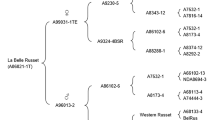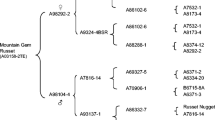Abstract
Premier Russet is a russet-skinned, high yielding potato cultivar suitable for processing or fresh-pack. Premier Russet is notable for its resistance to the accumulation of reducing sugars in its tubers. This characteristic allows tubers of Premier Russet to be stored at temperatures as low as 5.6°C for 250 days without the need for reconditioning prior to processing. The low temperature sweetening resistance of Premier Russet allows for its storage at colder temperatures which contributes to prolonged tuber dormancy and quality, and to a reduction in the incidence and severity of storage diseases associated with the higher storage temperatures typically used for industry-standard cultivars such as Russet Burbank and Ranger Russet. Premier Russet was released in 2006 by the USDA-ARS and the Agricultural Experiment Stations of Idaho, Oregon, and Washington, and is a product of the Northwest Potato Variety (Tri-State) Development Program. In full-season trials conducted over a 3-year period in the states of Idaho, Oregon, Washington, Colorado, California, New Mexico, and Texas, Premier Russet averaged 5% and 4% higher yields than Ranger Russet and Russet Burbank, respectively, and had a higher percentage of US No. 1 yield than either cultivar. Specific gravity of Premier Russet is consistently greater than that of Ranger Russet or Russet Burbank. Premier Russet is resistant to common and powdery scab, very resistant to the common strain of potato virus Y (PVYO), and moderately resistant to Verticillium wilt, early blight of the foliage and tuber, Pectobacterium (Erwinia) soft rot, and to galling of roots by powdery scab. Blackspot bruise reaction for Premier Russet is similar to that of Ranger Russet. The incidence of hollow heart in Premier Russet is higher than that of Ranger Russet or Russet Burbank. Cultural recommendations to manage hollow heart in Premier Russet are provided.
Resumen
Premier Russet es un cultivar de papa de cáscara rugosa y alto rendimiento, conveniente para procesamiento o consumo fresco. El “LS” en su designación clonal es una observación “bajo en azúcar” y es descriptivo de la resistencia que tiene este cultivar para la acumulación de azúcares reductores en el tubérculo. Esta característica permite que los tubérculos de Premier Russet se almacenen a temperatura tan baja como 5.6 C por 250 días sin necesidad de condicionamiento antes de procesar. La resistencia a endulzar por baja temperatura de Premier Russet permite su almacenamiento a menores temperaturas lo cual contribuye al prolongado estado de latencia y la calidad del tubérculo, y a la reducción en incidencia y severidad de enfermedades de almacén asociadas con alta temperatura típicamente usadas para cultivares estándar de la industria como Russet Burbank y Ranger Russet. Premier Russet fue liberada el 2006 por USDA-ARS y las Estaciones Experimentales Agrícolas de Idaho, Oregon y Washington y es producto del Programa de Desarrollo (Tri - State) de variedades de Papa Noroccidental. En pruebas del periodo de cultivo completo realizadas durante tres años en los estados de Idaho, Oregon y Washington, Colorado, California, Nuevo México y Texas, Premier Russet dio 5% y 4% rendimientos mas altos que Ranger Russet y Russet Burbank, respectivamente y tuvo los más altos porcentajes de producción de US N° 1 que ambos cultivares. La gravedad específica de Premier Russet es consistentemente mayor que Ranger Russet y Russet Burbank. Premier Russet es resistente a la sarna común y a la roña, muy resistente a la variante común del virus Y de la papa (PVY°) y moderadamente resistente a la marchitez, por Verticillium, tizón temprano del follaje y el tubérculo, pudrición blanda por Pectobacterium (Erwinia) y agallamiento de las raíces por roña. La reacción de mancha negra por magulladura de Premier Russet es similar a la de Ranger Russet. La incidencia de corazón vacío es más alta que en Ranger Russet o Russet Burbank. Se dan recomendaciones culturales para el manejo de corazón vacío en Premier Russet.



Similar content being viewed by others
References
Brandt T.L., N. Olsen, J. Stark and R. Novy. 2007. Storage management of A93157-6LS potatoes. University of Idaho Extension, Current Information Series (CIS) publication 1142.
Brown, C.R., H. Mojtahedi, G.S. Santo, P. Hamm, J.J. Pavek, D. Corsini, S. Love, J.M. Crosslin, and P.E. Thomas. 2000. Potato germplasm resistant to corky ringspot disease. Am J Potato Res 77: 23–27.
Brown, C.R., H. Mojtahedi, S. James, R.G. Novy, and S. Love. 2006. Development and evaluation of potato breeding lines with introgressed resistance to Columbia root-knot nematode (Meloidogyne chitwoodi). Am J Potato Res 83: 1–8.
Corsini, D., and J.J. Pavek. 1986. Fusarium dry-rot resistant potato germplasm. Am Potato J 63: 629–638.
Corsini, D.L., J.J. Pavek, and J.R. Davis. 1988. Verticillium wilt resistance in non-cultivated tuber-bearing Solanum species. Plant Dis 75: 148–151.
Corsini, D.L., J.J. Pavek, M.W. Martin, and C.R. Brown. 1994. Potato germplasm with combined resistance to leafroll virus and viruses X and Y. Am Potato J 71: 377–385.
Lang, N.S., R.G. Stevens, R.E. Thornton, W.L. Pan and S. Victory. 1999. Nutrient management guide: Central Washington irrigated potatoes. Washington State University Experiment Station Extension Bulletin EB1882.
Love, S.L., T. Salaiz, B. Shafii, W.J. Price, A.R. Mosley, and R.E. Thornton. 2004. Stability of expression and concentration of ascorbic acid in North American potato germplasm. HortScience 391: 156–160.
Love, S.L., R.G. Novy, J.L. Whitworth, D.L. Corsini, J.J. Pavek, A.R. Mosley, M.J. Pavek, N.R. Knowles, C.R. Brown, S.R. James, and D.C. Hane. 2006. Western Russet: A new potato variety with excellent fresh market and frozen-fried processing quality and field resistance to common scab and PVY0. Am J Potato Res 83: 161–169.
Mosley, A., S. Yilma, D. Hane, S. James, K. Rykbost, C. Shock, B. Charlton, E. Eldredge, and L. Leroux. 2003. Oregon. In: K G Haynes (ed), National Potato Germplasm Evaluation and Enhancement Report, 2001. pp. 369–388.
Novy, R.G., D.L. Corsini, S.L. Love, J.J. Pavek, A.R. Mosley, S.R. James, D.C. Hane, C.C. Shock, K.A. Rykbost, C.R. Brown, and R.E. Thornton. 2002. Bannock Russet: A dual purpose, russet potato cultivar with high U.S. No. 1 yield and multiple disease resistances. Am J Potato Res 79: 147–153.
Pavek, J.J., D.R. Douglas, H.C. McKay, and R.E. Ohms. 1973. Targhee: An oblong russet potato variety with attractive tubers and high resistance to common scab. Am Potato J 50: 293–296.
Pavek, J.J., D.L. Corsini, D.R. Douglas, R.E. Ohms, J.G. Garner, H.C. McKay, C. Stanger, G.E. Vogt, W.C. Sparks, R. Kunkel, J.R. Davis, A.J. Walz, C.E. Dallimore, and J. Augustin. 1978. Butte: A long russet potato variety with excellent dehydrating quality. Am Potato J 55: 685–690.
Ross, F.A. 1959. Dinitrophenol method for reducing sugars. In: W.F. Talburt and O. Smith, (eds.), Potato Processing, AVI Publ., Westport, Connecticut pp. 469–470.
Simpson, G.W., and R.V. Akeley. 1964. Penobscot: A new variety of potato with leafroll resistance and high solids. Am Potato J 62: 517.
Stark, J., D. Westermann, and B. Hopkins. 2004. Nutrient management guidelines for Russet Burbank potatoes. University of Idaho Extension Bulletin No. 840, 12 p.
United States Standards for Grades of Potatoes. 1997. United States Department of Agriculture, Agricultural Marketing Service. p 2.
Webb, R.E., D.R. Wilson, J.A. Frank, J.R. Shumaker, B. Graves, and M.R. Henninger. 1981. BelRus: A new russet skin potato variety, combining high quality, pest resistance, and adaptation to the northeastern United States and Florida. Am Potato J 58: 111–116.
Acknowledgements
The authors thank Margaret Bain, Eric Eldredge, Mary Jo Frazier, Nora Fuller, Darren Hall, Mark Fristad, Charlene Miller, Tom Salaiz, Brian Schneider, Lura Schroeder, Penny Tubbs, Steve Wheeler, and Solomon Yilma for their contributions to the development and release of Premier Russet. We also thank Jim Whitmore and Lori Ewing, University of Idaho, for their efforts in developing foundation and certified seed of Premier Russet, as well as our industry cooperators, our collaborators in the Western Regional Potato Variety Trials, and the Idaho, Washington, and Oregon potato commissions. Special thanks as well to Kathy Haynes and Creighton Miller for their reviews of this manuscript and their helpful comments. Development of Premier Russet was partially funded by the USDA/CSREES Special Potato Program Grant.
Author information
Authors and Affiliations
Corresponding author
Rights and permissions
About this article
Cite this article
Novy, R.G., Whitworth, J.L., Stark, J.C. et al. Premier Russet: A Dual-Purpose, Potato Cultivar with Significant Resistance to Low Temperature Sweetening During Long-Term Storage. Am. J. Pot Res 85, 198–209 (2008). https://doi.org/10.1007/s12230-008-9013-7
Published:
Issue Date:
DOI: https://doi.org/10.1007/s12230-008-9013-7




